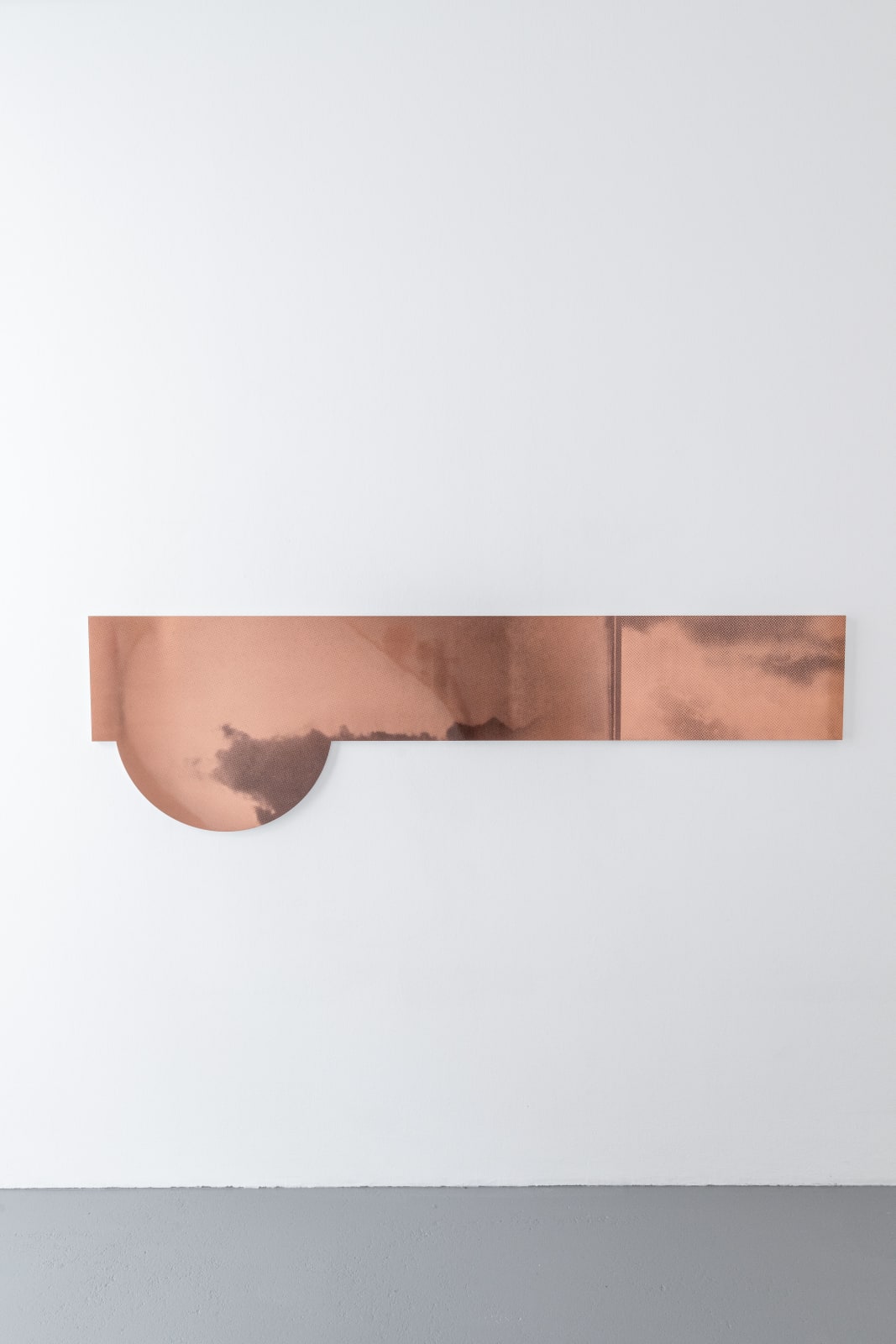Sébastien de Ganay
Seascape 10, 2021
Copper plate sandwich with aluminum, print, varnish and felt
61 x 211 x 2 cm
24 x 83 1/8 x 3/4 inches
24 x 83 1/8 x 3/4 inches
Copyright The Artist
Photo: Dirk Tacke
Weitere Abbildungen
In der 2011 begonnen Werkserie „Seascapes“ erkundet de Ganay Fläche als freie, variable Form sowie als Referenz an die „Shaped Canvases“ der Minimal Art. Auf Kupferplatten setzt er Ausschnitte von...
In der 2011 begonnen Werkserie „Seascapes“ erkundet de Ganay Fläche als freie, variable Form sowie als Referenz an die „Shaped Canvases“ der Minimal Art. Auf Kupferplatten setzt er Ausschnitte von Meeresblick-Fotografien des Fotopioniers Gustave Le Grey aus den Anfangszeiten des Genres in der Mitte des 19. Jahrhunderts. Die verschiedenen Aneignungsmodi werden durch die neue Form und die Materialität aus reflektierendem Kupfer zugleich sichtbar und entfremdet. Früh löste sich der Künstler in der Malerei von der rechteckigen Leinwand und variiert seitdem mit kreisförmigen, sich teilweise überlappenden, Modulen in verschiedenen Größen und Materialien. In „Seascapes“ ist die Form des Kreises auch von de Ganays Reisen nach Japan inspiriert, wo der Kreis in Zen-Gärten und Klöstern als Symbol der Erkenntnis häufig wiederkehrt sowie in Zeichnungen, Objekten oder als architektonisches Element als Fenster, das Ausblick in die Landschaft gibt und gleichzeitig auf das Innen und Außen der betrachtenden Person verweist. De Ganay siedelt seine Arbeiten bewusst zwischen künstlerischen Genres an, wobei die „Seascapes“ zwischen Objekt, Malerei und Fotografie changieren sowie Vergangenheit und Gegenwart miteinander verbinden. Der Farbton des spiegelnden Kupfers greift die düstere Stimmung der Seelandschaften der Normandie und Britanniens auf und erinnert durch die Sepia-Färbung an frühe Fotografien.
Das schweifende Auge der betrachtenden Person, dass sich normalerweise in der Landschaft verliert, wird durch die spiegelnde Oberfläche des Kupfers zurückgeworfen und bringt ein Fragment der Gegenwart in die frühen Bilder Le Greys. De Ganay lässt in „Seascapes“ – wie bei „Pavillon Naked“ – die Betrachter/innen Teil des Kunstwerks werden und fordert sie somit dazu auf sich im Galerieraum, aber auch im Bildraum neu zu verordnen.
In the series of works, ”Seascapes“, begun in 2011, de Ganay explores the surface as a free, variable form as well as a reference to the ”Shaped Canvases“ of Minimal Art. He places excerpts from sea view photographs by photography pioneer Gustave Le Gray from the early days of the genre, mid-19th century, onto copper plates. The different modes of appropriation are both visible and alienated by the new shape and the materiality of reflective copper. Early in his career, the artist broke away from using rectangular canvases; instead favoring circular forms and partially overlapping modules in various shapes and sizes. In ”Seascapes“, the circular shape is also inspired by de Ganay's travels to Japan, where the circle often appears in Zen gardens and monasteries as a symbol of knowledge. It also recurs in drawings, objects or as architectural elements such as windows, giving a view of the landscape and simultaneously referring to the viewer’s internal and external worlds. De Ganay deliberately places his work between artistic genres, whereby the ”Seascapes“ alternate between object, painting and photography, combining the past and the present. The reflective copper sepia hue picks up on the gloomy moods of seascapes in Normandy and Brittany, reminiscent of early photographs.
The viewer’s wandering eye, usually lost in the landscape, is reflected back by the reflective copper surface and brings a fragment of the present into Le Grey's early pictures. In ”Seascapes“ – as also in ”Pavillon Naked“ – De Ganay lets the viewer become part of the work and thus challenging them to reorganize themselves within the gallery space, as well as in the pictorial space.
Das schweifende Auge der betrachtenden Person, dass sich normalerweise in der Landschaft verliert, wird durch die spiegelnde Oberfläche des Kupfers zurückgeworfen und bringt ein Fragment der Gegenwart in die frühen Bilder Le Greys. De Ganay lässt in „Seascapes“ – wie bei „Pavillon Naked“ – die Betrachter/innen Teil des Kunstwerks werden und fordert sie somit dazu auf sich im Galerieraum, aber auch im Bildraum neu zu verordnen.
In the series of works, ”Seascapes“, begun in 2011, de Ganay explores the surface as a free, variable form as well as a reference to the ”Shaped Canvases“ of Minimal Art. He places excerpts from sea view photographs by photography pioneer Gustave Le Gray from the early days of the genre, mid-19th century, onto copper plates. The different modes of appropriation are both visible and alienated by the new shape and the materiality of reflective copper. Early in his career, the artist broke away from using rectangular canvases; instead favoring circular forms and partially overlapping modules in various shapes and sizes. In ”Seascapes“, the circular shape is also inspired by de Ganay's travels to Japan, where the circle often appears in Zen gardens and monasteries as a symbol of knowledge. It also recurs in drawings, objects or as architectural elements such as windows, giving a view of the landscape and simultaneously referring to the viewer’s internal and external worlds. De Ganay deliberately places his work between artistic genres, whereby the ”Seascapes“ alternate between object, painting and photography, combining the past and the present. The reflective copper sepia hue picks up on the gloomy moods of seascapes in Normandy and Brittany, reminiscent of early photographs.
The viewer’s wandering eye, usually lost in the landscape, is reflected back by the reflective copper surface and brings a fragment of the present into Le Grey's early pictures. In ”Seascapes“ – as also in ”Pavillon Naked“ – De Ganay lets the viewer become part of the work and thus challenging them to reorganize themselves within the gallery space, as well as in the pictorial space.



